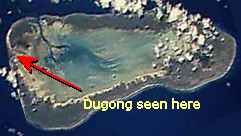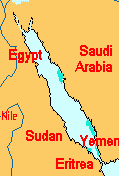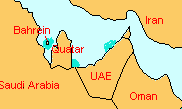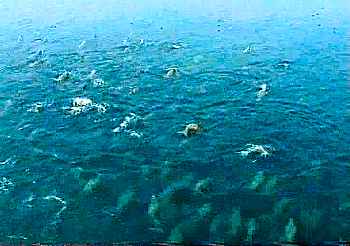Status of the World Dugong Population by Country
(1 of 4)
AFRICA TO ARABIAN/PERSIAN GULF
Along the East African Coast there are breeding grounds in the Bazaruto Archipelago off Mozambique and in the Dodori and Kiunga National Reserves at the north eastern cost of Kenya.
East African Dugongs Disappearing: "I am sad to report that we are rapidly losing the battle to protect the last of the dugongs on the east African coast. Kenya and Tanzania have all but lost their populations, and the last viable population in the Bazaruto Archipelago in Mozambique is down from 110 in 1993 to about 21 in September 1997, according to my last air survey. Gillnets set in seagrass habitats for shark harvesting still continue to plunder the populations in spite of repeated attempts to have the gillnets banned." (as per Sirenews 29 April 98 - by Paul Dutton (Dutton Environmental Consultants, 118 Mansfield Road, Durban 4001, South Africa; tel./fax: (031)215 788; e-mail)
The Dugong is heavily exploited by the local people. Although it has legislative protection in much of the region, enforcement is inadequate.
Mozambique
Dugong numbers are declining throughout Mozambican waters, possibly as a result of capture and/or habitat degradation. The dugong population inhabiting Bazaruto Bay is probably the last remaining large population of dugongs off the east coast of Africa. Some 80 to 90 animals were counted there in two aerial surveys in 1991 and 1992. Dugongs are rarely seen in Maputo Bay, but they are incidentally captured in gill nets and even actively hunted for their meat. Surveys indicate only a small population, some two or three animals, on the outer reaches of the Bay, where fisheries pressure is low and the water clear.
A conservation project (the "Bazaruto Bay project") has been instituted, whose central purpose is to make recommendations for the conservation and management and seeking to promote an awareness of the value of coastal ecosystems in Mozambique through education programs in local communities.
Madagascar
The results of a preliminary questionnaire survey in late 1993 revealed heavy exploitation and degradation of coastal resources. In all areas sampled, fishermen rarely see dugongs; in some areas they have not been seen for 10 to 20 years; younger fishermen do not know the name for dugong in their own language. Dugong meat is prized and although fishermen do not admit to direct takes, most will consume dugongs taken incidentally. Small numbers of dugongs are known to occur along the central to northwestern coast and on the northeastern coast of Madagascar, but nowhere are they abundant.
Comoros Islands
Dugongs apparently still occur here, but in small numbers.
Seychelles and Mauritius
Dugongs occurred off all or most of these islands, but were apparently extirpated early this century. The last large dugong herds were seen in the mid-1800s, and the last individual around 1908.

In the year 2001 dugongs have again been seen in the
Aldabra Atoll (belonging to the Seychelles) on four
occasions since August 2001. Most of the time it has
been one dugong but on the third occasion two dugongs
were spotted in the same area. The dates of the
sightings were on 02/08/01, 03/08/01, 01/10/01 and
12/10/01.
Last info 2005: 4 resident Dugong in Aldabra.
--->
More about Dugong in
Aldabra.
Kenya
A recent questionnaire survey of Kenya's artisanal fishermen indicates that dugongs are rarely seen, but still sporadically taken. Although dugongs have been reported recently in the south, none was seen there in a recent aerial survey by the Kenya Wildlife Service. During the 250 hours of survey time, only 16 dugongs were sighted, all in the north, implying a population of about 50 individuals.
Somalia
Anecdotal information indicates that dugongs are often seen in the south (Bajuni Islands) and there are reports of a large group migrating between the north of Kenya and Somalia.
Red Sea States
Erithrea, Somalia, Sudan, Egypt, Saudi Arabia.
 Dugongs are reported to occur in the
waters of all Red Sea states, though estimates of
numbers are available only for Saudi Arabia -
approximately 1,800. The status of dugongs off other
Red Sea states is unknown, other than from anecdotal
reports.
Dugongs are reported to occur in the
waters of all Red Sea states, though estimates of
numbers are available only for Saudi Arabia -
approximately 1,800. The status of dugongs off other
Red Sea states is unknown, other than from anecdotal
reports.
The Red Sea is considered to be one of the least damaged bodies of water in the world. In 1986 Preen estimated that the Red Sea potentially supported up to 4000 dugongs. If these estimates are confirmed, the Red Sea contains the second largest population of the animal in its western range, next to the Arabian/Persian Gulf.
Arabian/Persian Gulf States
Oman, United Arab Emirates, Qatar, Bahrain, Saudi Arabia, Kuwait, Iraq, Iran:
Fieldwork in the mid-1980s resulted in
highly significant new findings. Dugongs are now
known to occur in western and southern parts of the
Gulf, mainly between Ras Tanura (in Saudi Arabia) and
Abu Dhabi (United Arab Emirates).  The three principal areas are: west and
east of Bahrain, in the enclave of Saudi Arabian
territory between Qatar and the UAE, and to the west
of Abu Dhabi. The estimated Gulf population comprises
7,310 animals (+/- 1,300). On this basis, the
Gulf is easily the most important area in the western
half of the species' range, and globally second
only to Australia. Degradation of the seagrass beds
in the Gulf will have a serious impact on the global
status of this species.
The three principal areas are: west and
east of Bahrain, in the enclave of Saudi Arabian
territory between Qatar and the UAE, and to the west
of Abu Dhabi. The estimated Gulf population comprises
7,310 animals (+/- 1,300). On this basis, the
Gulf is easily the most important area in the western
half of the species' range, and globally second
only to Australia. Degradation of the seagrass beds
in the Gulf will have a serious impact on the global
status of this species.
Dugong in the UAE mostly inhabit the shallow waters around the islands of Murawah and Bu Tina to the west of Abu Dhabi, but their range extends further west to the border of Qatar and beyond and there is still the occasional sighting to the east around Jebel Ali, Umm-Al-Quwain and Ras al Khaimah. There are no confirmed records of dugongs in the Gulf of Oman.
 Every winter, during February, large
numbers of them congregate in the sea area around
Qatar. Once thought to be on the verge of extinction,
recent helicopter surveys have revealed that over 600
sea cows, including families of parents and their
young, may occur in the region. Although they are
generally very wary of contact with people, when they
are densely aggregated it is possible to approach
them quite closely by boat, providing the engine is
switched off and one drifts among them. Efforts to
photograph dugongs underwater are usually frustrated
by relatively poor visibility which is exacerbated as
they stir up the seabed whilst feeding.
Every winter, during February, large
numbers of them congregate in the sea area around
Qatar. Once thought to be on the verge of extinction,
recent helicopter surveys have revealed that over 600
sea cows, including families of parents and their
young, may occur in the region. Although they are
generally very wary of contact with people, when they
are densely aggregated it is possible to approach
them quite closely by boat, providing the engine is
switched off and one drifts among them. Efforts to
photograph dugongs underwater are usually frustrated
by relatively poor visibility which is exacerbated as
they stir up the seabed whilst feeding.
The Gulf of Salwah and the waters south-east of Bahrain is a core area for the local Dugong population, which numbers about 2,500-3,500.
Japan + Australia <<
October 2001